Number of stations 112 | Transit type Rapid transit | |
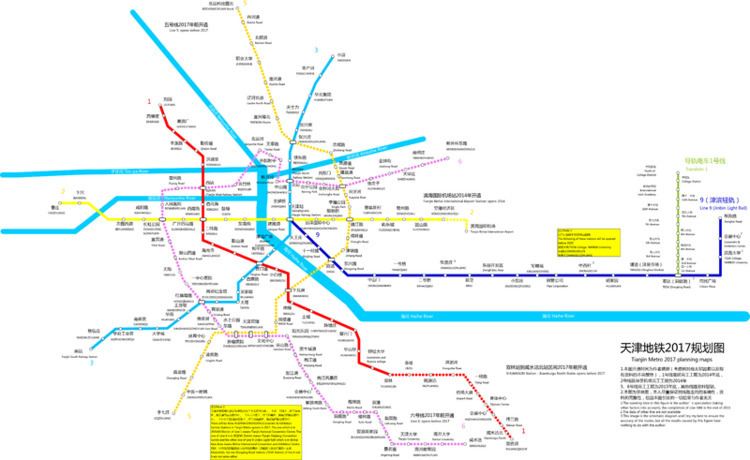 | ||
Number of lines 5 operational1 under construction9 planned Daily ridership 701,000 (2015 Avg.)1,080,700 (2014 peak) Annual ridership 41.8 million (2010)(BMT excluded) | ||
Tianjin metro line 9 shiyijing road tianjin railway station 8 10 2015
The Tianjin Metro is the current rapid transit system in the city of Tianjin, which was the second city (after Beijing) in China to operate a subway system. Opened in 1984, the system now has 5 operating lines and 95 stations spanning over a total of 132.4 km. The lines are jointly operated by two rapid transit companies, namely the Tianjin Metro Group Co. Ltd and the Binhai Mass Transit Development Co. Ltd. The former mainly operates lines in the downtown, while the latter operates lines that serve the Binhai New Area and TEDA.
Contents
- Tianjin metro line 9 shiyijing road tianjin railway station 8 10 2015
- Tianjin metro line 9 tianjin railway station dawangzhuang 8 10 2015
- History
- Line 1
- Line 2
- Line 3
- Line 6
- Line 9
- TEDA Modern Guided Rail Tram
- Rolling stock
- Fares
- One way ticket
- Common Stored Value Ticket
- Student discount tickets and tickets for the elderly
- Half price tickets and by sub votes
- City Card
- Future subway plans
- Line 5
- Planned lines
- Proposed lines long term
- References

Tianjin metro line 9 tianjin railway station dawangzhuang 8 10 2015
History
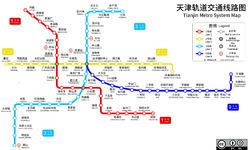
Tianjin, as an inland harbor of China, has long been a major commercial city. After the founding of the People's Republic in 1949, the number of vehicles on the roads significantly increased, causing pollution. To overcome these problems, the transport authority decided to close the old tram network and switch over to a rapid transit system.
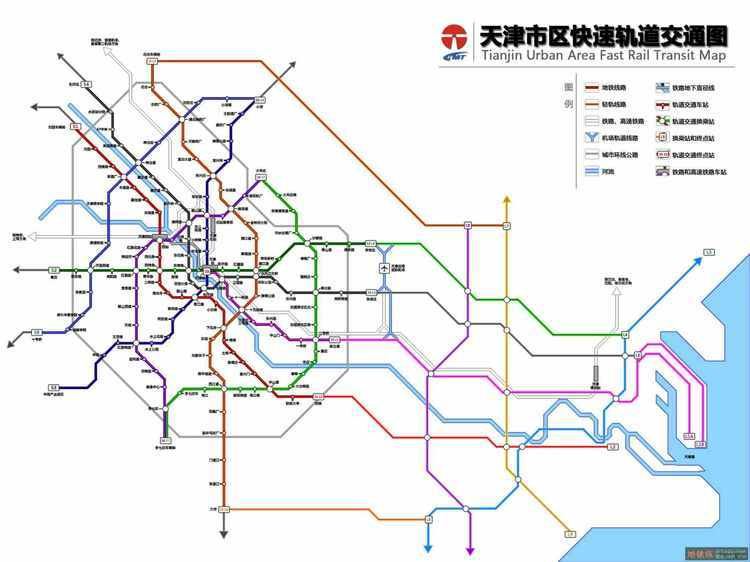
However, due to economic costs, it was not until 1970 that construction of the system first took place. The first section, spanning 3.6 km of track and 4 stations, namely Xinhualu, Yingkoudao, Anshandao and Haiguangsi stations, was completed by February 1976. The second section, with an additional 1.6 km of track and the Xinanjiao and Erweilu stations, was completed by 1980. After construction resumed, the total length was 7.4 km, with 8 stations, and service on the line began on December 28, 1984.

To reduce construction costs, the transport authority decided to use an abandoned canal bed to form part of the system, and did not dig deeply. By using the canal bed, the underground section is only 2–3 meters under the street surface, and was the world's shallowest metro. There were only 1,000 full-time construction workers at that time; the others were volunteers from factories, schools and institutions all over the city. The average number of volunteer workers exceeded 2,000 a day, which rendered the project unique in the world then. Construction was delayed in 1976 when an earthquake hit the city, but was resumed in 1979 and completed by 1984.
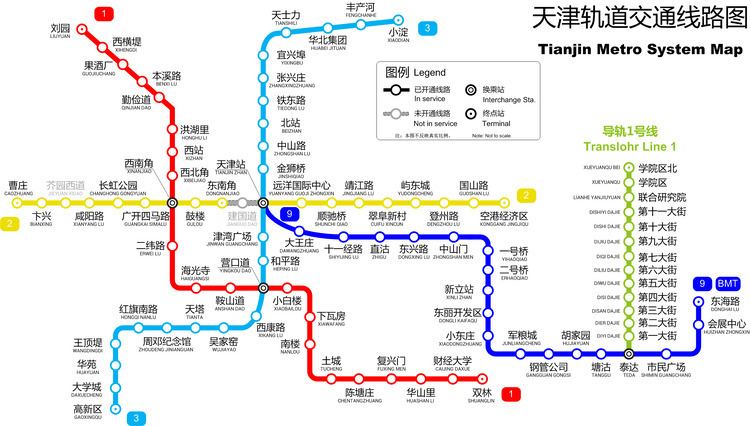
At the end of the 1990s, it was observed that the Metro system was quite out of date. The atmosphere of the stations was uninviting, difficult to navigate, and with few passenger amenities on the platforms. Trains were infrequent, sporadic and commonly delayed. The trains themselves were dilapidated, seat covers often torn off, and dim. Taking into consideration more modern, cleaner systems in East Asia, a massive reconstruction, modernization and expansion plan was laid out in 2000. In preparation, the system was closed on 1 September 2001, with renovation fully starting on 21 November. After purchasing new rolling stock, adding half-height platform screen doors and extending the line up to Shuanglin, the line re-opened on 6 December 2006 as Line 1, after trial testing that began on 12 June of that year.
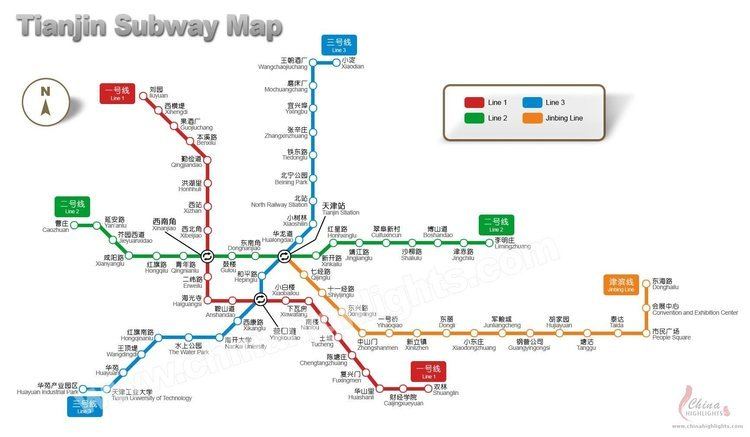
During the renovation of the first line, other lines underwent construction. Line 9, operated by Binhai Mass Transit Development Co. Ltd, began construction in 2001 and its first section opened on 28 March 2004. Between 2004 and 2007, many new stations on the line opened successively. On 1 May 2011, the line was further extended westwards by 3 stations, bringing it to its current length of 52.8 km. The Tram line in the system, the TEDA Modern Guided Rail Tram, was built to serve the Tianjin Economic Development Area and was opened on 10 May 2007. Line 2, after a lengthy construction delay and a structural accident, finally opened, as two separate sections, to the public on 1 July 2012, with the sections being reconnected on 28 August 2013. Line 3, another main north-south line, opened in October 2012.
Line 1
Line 1 is built upon the old surface-level line, and was opened in 2006, spanning 26.2 km with 22 stations. The Shuanglin station has closed for upgrading on December 28th, 2016. And the old rolling stocks (DKZ9 Series) were replaced at the same time.
Line 2
Line 2 opened for trial operations on 1 July 2012. Due to a structural accident in Jianguodao Station, Line 2 was operated as two separate sections from July 2012 to 28 August 2013, when the affected station opened after being rebuilt. The line is 22.7 km long with 19 stations.
Line 3
The line, running southeast-northwest, opened on 1 October 2012. It is 22.3 km long with 21 stations. 20 km of track is underground, with 1.2 km at ground level and the rest on elevated viaducts. Of the 21 stations, one is elevated, one is at ground level and the other 19 are underground.
Line 6
Line 6 will run from Xinwaihuandonglu to Xianshuigu.
The full line is under construction and will be 50.1 km long with 38 stations. The first 8 station section of the line from Changhong Gongyuan to Nancuiping was opened in August 2016. The second section from Nansunzhuang to Nancuiping was opened in December 31th, 2016. Expanding the line to 21 stations. Line 6, together with Line 5 will form a loop around Tianjin.
Line 9
Line 9 is an east-west line running just north of the Haihe River. It was opened in 2004, spanning 52.8 km with 19 stations. The line is operated by Tianjin Binhai Mass Transit Development Co. Ltd and provides interchange to the TEDA Tram line. Line 9 was suspended after damage from the August 2015 explosions, and resumed operation on December 16 from Tianjin Railway Station to Tianjin Pipe Corporation Station.
TEDA Modern Guided Rail Tram
The TEDA Tram is a tram line that runs between TEDA and North of College District stations, mainly serving the Tianjin Economic Development Area (TEDA). It opened on May 10, 2007 and is 7.86 km long.
Rolling stock
There were older, box-type metro cars, built by Nippon Sharyo until the system was closed for reconstruction. After re-opening, 114 CNR Changchun Railway Vehicle Company Limited Rapid Train set Vehicle cars entered service & replaced the old ones. Unlike the old cars, the CNR cars contain air conditioning.
Fares
Tianjin Metro uses magnetic smartcards. The fare is distance-based and ranges between 2 and 5 Yuan.
One-way ticket
One-way tickets are available at automatic ticket machines, where passengers can purchase up to 9 tickets. The tickets are only effective in three hours from purchase. You can purchase it from the automatic ticket machine, and recycle it by simply insert it into the turnstile when you leave the station.
Common Stored Value Ticket
Stored-value tickets can be repeatedly used for the regular subway passengers, the fare for each journey outbound passengers through the gates when the balance deducted from the stored-value tickets. Within one year of non-use of stored-value tickets as expired, outdated stored-value tickets available at the station free update procedures for handling customer service center. Common Stored Value Ticket holders to enjoy 10% off travel.
Student discount tickets and tickets for the elderly
All full-time students attending schools, technical secondary, craftsmen, and vocational schools with student ID issued by letter may purchase student tickets and enjoy a student discount.
Seniors between 60 and 69 years old with a "Tianjin old preference card" (green) can buy discounted senior tickets, seniors 70 years old and older, with a "Tianjin old preference card" (purple) may purchase specially discounted tickets.
Half-price tickets, and by sub-votes
On December 8, 2006, Tianjin Metro Line 1 to "discount fares for winter warmth activities" to launch half-price ticket, take the second ticket and group ticket three kinds of tickets.
Half-price ticket card prepaid value of 200 Yuan, the sale price of 100 Yuan, 10 Yuan deposit required to pay extra for a total purchase price of 110 per issue. So doing half-price ticket fare can be enjoyed nine discount and eventually converted into 4.5 fold. Half-price tickets from the purchase date (including day of) 90 days, the use of force within the validity period can not be re-Recharge, the amount within 90 days after the ticket automatically cleared, tickets void. Expires, the coupon no damage present their deposit slip and a detailed description to any customer service center station refundable deposit of 10 Yuan.
By sub-votes is divided into two kinds: first, the amount of 35 Yuan ticket can take 20 times, pay extra 10 Yuan deposit for a total purchase price of 45. The second vote the amount of 80 can take 50 times, pay extra 10 Yuan deposit for a total purchase price of 90. By sub-vote from the date of purchase, valid for 30 days after expiry, the card automatically cleared by Ci. If all the x-use within the validity period has finished, you can vote again to take within the Result purchase the corresponding times, since the Result date, the purchase by meeting the entry into force is still valid for 30 days. As of 2007 December 30, by sub-votes will not accept refill, take the time to use the remaining card after the ticket void.
City Card
The City Card is a non-contact type IC card Transit card similar to the Yikatong card in Beijing. It is accepted in subway, light rail, bus, ferry and taxi transport. Since December 28, 2006, City Card is accepted on the Metro Line 1. City Card holders can enjoy a discounted fare during transfers between modes. This is the most popular method for long distance traveling. Ferryboat and bus fares are not distance based.
Future subway plans
In 2009, the Tianjin transport authority announced plans for 8 subway lines and a few light rail lines. Subway Lines 5 and 6, currently under construction, are scheduled to open in 2015; the dates of completion for further lines have not yet been announced.
Line 5
Line 5 will run from Beichenkejiyuan North to Liqizhuang.
This line is under construction and will be 35.5 km long with 24 stations. Completion was originally scheduled for 2012, but now scheduled for late 2015. It will connect with BMT Line B7 on the north terminal and with BMT Line 6 on the south terminal.
Planned lines
All station names and routes are tentative, and the lines will begin construction after the completion of Lines 2, 3, 5 and 6.
Proposed lines (long-term)
Lines that are currently on the long-term planning list are 10-13 (Subway) and B2-B9 (Light rail).
